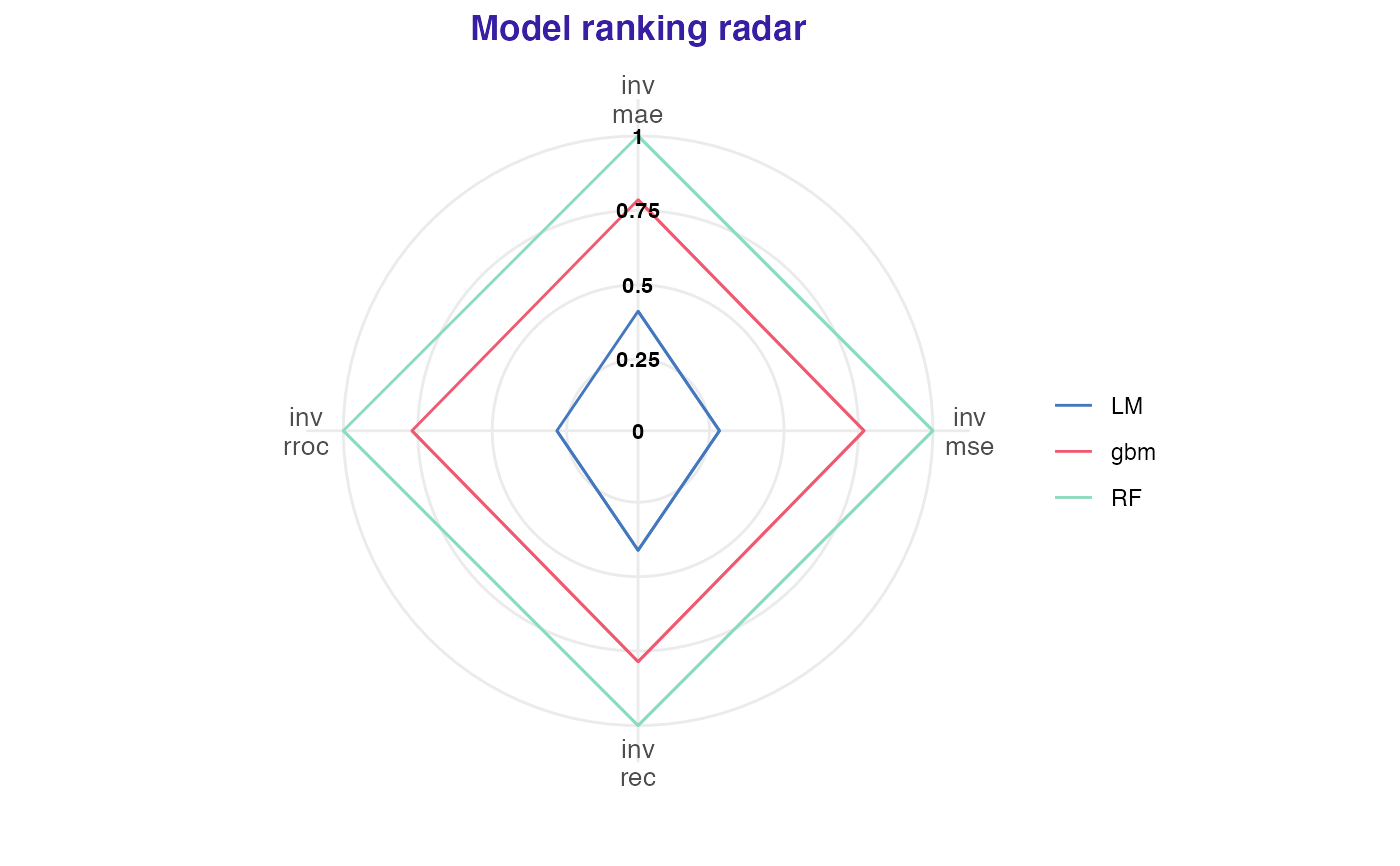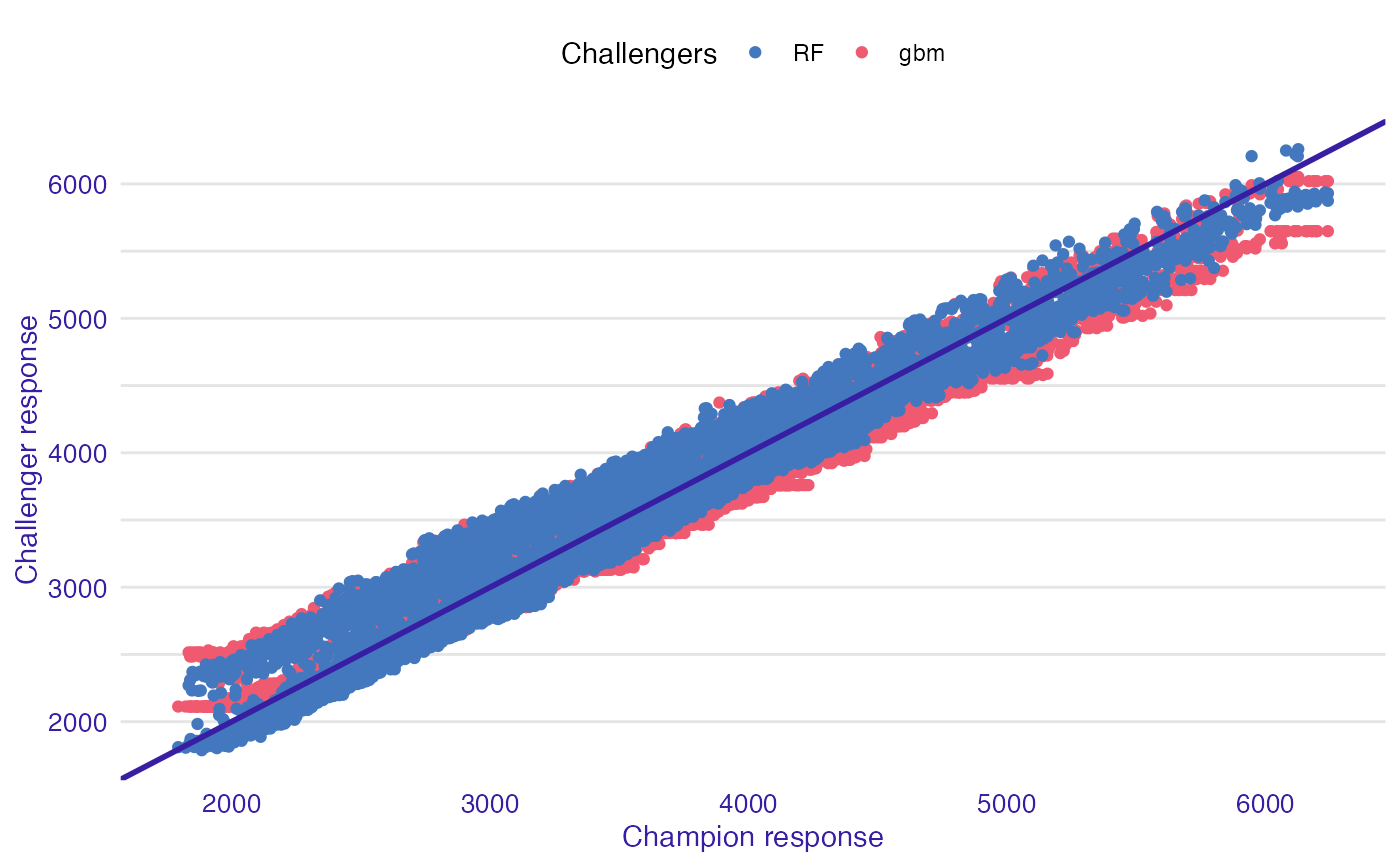The function creates objects that present global model performance using various measures. Those date can be easily
plotted with plot function. It uses auditor package to create model_performance of all passed
explainers. Keep in mind that type of task has to be specified.
overall_comparison(champion, challengers, type)Arguments
- champion
- explainer of champion model.
- challengers
- explainer of challenger model or list of explainers.
- type
- type of the task. Either classification or regression
Value
An object of the class overall_comparison It is a named list containing following fields:
radarlist ofmodel_performanceobjects and other parameters that will be passed to genericplotfunctionaccordancedata.frame object of champion responses and challenger's corresponding to them. Used to plot accordance.models_infodata.frame containing information about models used in analysis
Examples
# \donttest{
library("DALEXtra")
library("mlr")
task <- mlr::makeRegrTask(
id = "R",
data = apartments,
target = "m2.price"
)
learner_lm <- mlr::makeLearner(
"regr.lm"
)
model_lm <- mlr::train(learner_lm, task)
explainer_lm <- explain_mlr(model_lm, apartmentsTest, apartmentsTest$m2.price, label = "LM")
#> Preparation of a new explainer is initiated
#> -> model label : LM
#> -> data : 9000 rows 6 cols
#> -> target variable : 9000 values
#> -> predict function : yhat.WrappedModel will be used ( default )
#> -> predicted values : No value for predict function target column. ( default )
#> -> model_info : package mlr , ver. 2.19.0 , task regression ( default )
#> -> predicted values : numerical, min = 1792.597 , mean = 3506.836 , max = 6241.447
#> -> residual function : difference between y and yhat ( default )
#> -> residuals : numerical, min = -257.2555 , mean = 4.687686 , max = 472.356
#> A new explainer has been created!
learner_rf <- mlr::makeLearner(
"regr.ranger"
)
model_rf <- mlr::train(learner_rf, task)
explainer_rf <- explain_mlr(model_rf, apartmentsTest, apartmentsTest$m2.price, label = "RF")
#> Preparation of a new explainer is initiated
#> -> model label : RF
#> -> data : 9000 rows 6 cols
#> -> target variable : 9000 values
#> -> predict function : yhat.WrappedModel will be used ( default )
#> -> predicted values : No value for predict function target column. ( default )
#> -> model_info : package mlr , ver. 2.19.0 , task regression ( default )
#> -> predicted values : numerical, min = 1787.508 , mean = 3504.632 , max = 6258.499
#> -> residual function : difference between y and yhat ( default )
#> -> residuals : numerical, min = -542.5728 , mean = 6.891499 , max = 758.0745
#> A new explainer has been created!
learner_gbm <- mlr::makeLearner(
"regr.gbm"
)
model_gbm <- mlr::train(learner_gbm, task)
explainer_gbm <- explain_mlr(model_gbm, apartmentsTest, apartmentsTest$m2.price, label = "gbm")
#> Preparation of a new explainer is initiated
#> -> model label : gbm
#> -> data : 9000 rows 6 cols
#> -> target variable : 9000 values
#> -> predict function : yhat.WrappedModel will be used ( default )
#> -> predicted values : No value for predict function target column. ( default )
#> -> model_info : package mlr , ver. 2.19.0 , task regression ( default )
#> -> predicted values : numerical, min = 2112.394 , mean = 3501.82 , max = 6051.511
#> -> residual function : difference between y and yhat ( default )
#> -> residuals : numerical, min = -509.3936 , mean = 9.703829 , max = 696.808
#> A new explainer has been created!
data <- overall_comparison(explainer_lm, list(explainer_gbm, explainer_rf), type = "regression")
plot(data)
#> $radar_plot
 #>
#> $accordance_plot
#>
#> $accordance_plot
 #>
# }
#>
# }